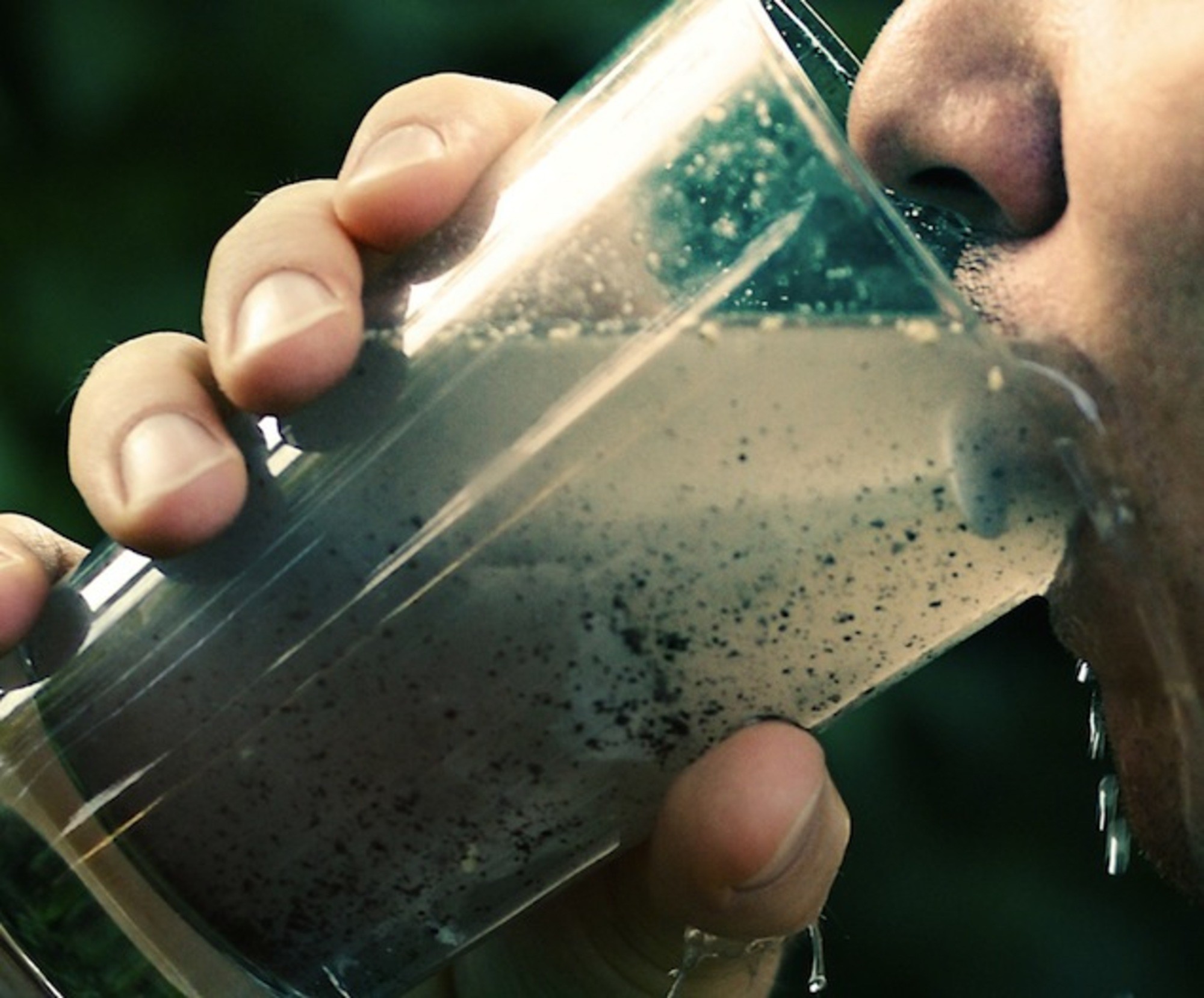
My first material - a comparison of household water filters
"Who Stirs Water" was prepared in the heat of a migrant researcher. When you first move to your own apartment, you begin to pay attention to small things - because you do and buy for yourself, and you have to have everything “for the ages.” In the post I shared my experience of comparing jug filters and sorption flow filters from different manufacturers. There were no plans to awaken the militant commentators from the beginning ... And then they knocked on the person's
door and said: “Write again, you will be a guest!”. And I wrote.
My name is Dmitry Mikhaylenkov, I work in a chemical industry enterprise, and therefore in my life chemistry for me is a matter of intense personal interest.
The first material was born from a comparison of household water filters, which I spent in search of the optimal solution for my new apartment. In that post, my colleague and I compared pitcher and sorption flow filters from different manufacturers, and also shared our findings with readers. To tell the truth, did not expect that the material will cause such interest on Geektimes, and will collect so many comments. And what I did not exactly expect that the filter manufacturers, studied and analyzed in our article, would react so promptly. Nevertheless, representatives of
Aquaphor turned to me (their developers also read Habr) and invited me to become a guest of their blog. Naturally, I did not refuse.
In the comments to the first comparison, many readers asked why I did not compare reverse osmosis filters. The answer is simple: the cost of each is around 7-8 thousand rubles. I am, of course, an enthusiast, but not to such an extent that for the sake of an interesting experiment and useful article to part with such a large sum.
In general, the cards came together: I agreed to write to the Aquaphor blog, provided that they give me a sample of my most advanced reverse osmosis filter, Aquafor Morion, and cover the cost of buying an opponent filter for the upcoming comparison.
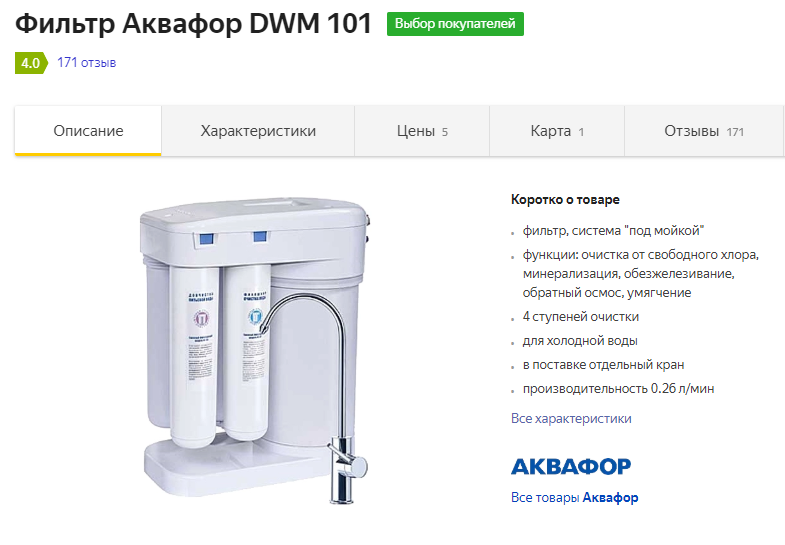
I chose rival Aquafor at my own discretion - I liked “Barrier Profi Osmo 100”, which, judging by the reviews on Yandex.Market, is very popular. This filter is a sample of a high-quality “standard” reverse osmosis filter, in my opinion, an excellent competitor for Aquaphor Morion. Moreover, both are in the same price category "about 8,000 rubles."
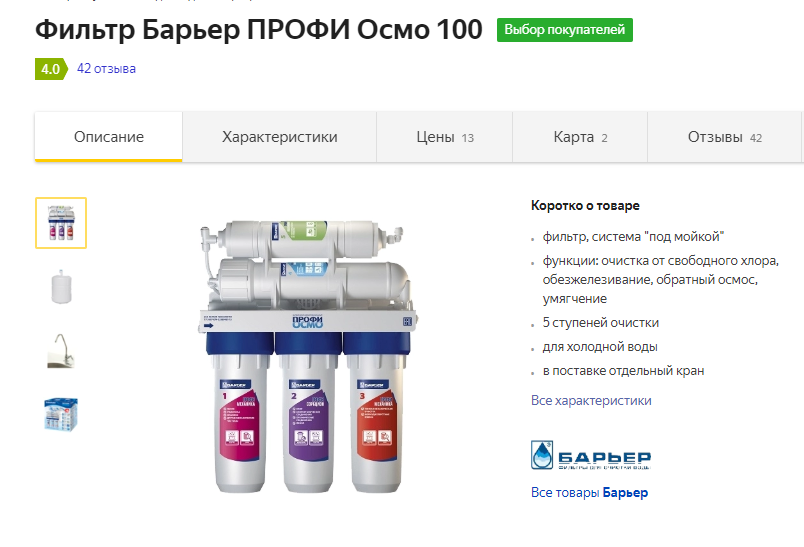
But first of all, before proceeding with the comparison, I will conduct a small educational program for those who are not at all in the subject.
What are good reverse osmosis filters?
Household filters for additional purification of drinking water can be divided into three types.
The first view. Filter jugs. They are cheaper, they are mobile. Filter jugs purify water from chlorine, rust, heavy metals and organics. But, if you have to soften hard water, jug cartridges do not remain effective for a long time, they will have to be changed very often. And also the jugs cannot cope with biological pollution - the water after them needs to be boiled, especially if you are not sure of its bio-safety. From the well scored, for example.
The second view. Flow sorption filters that are connected to the water supply (usually in the kitchen under the sink). Such filters give good water purification from most pollutants - the percentage of chlorine, rust, heavy metals and organic removal from stationary filters is much higher. They can purify water from hardness salts for a longer period, compared to jugs. But they do not purify water from viruses, and require frequent regeneration of softening cartridges.

And finally, the third type. Reverse-osmosis filters are the purification of water in general from all impurities. Remove from water 100% hardness salts, 100% rust, 100% heavy metals, 100% bacteria and parasite cysts. Reverse osmosis detains even viruses, which no other type of household water treatment systems can handle. At the outlet of the reverse osmosis filtration system, the purest water is obtained, which can be safely and safely drunk without boiling - this is H20 in its pure form.
Fact for lovers of bottled water: most brands of bottled drinking water for sale are ordinary tap (or artesian) water that has been cleaned in a reverse osmosis filter and flavored with a small amount of mineral impurities to impart a pleasant taste. And we are talking about water for 30 rubles / liter, and for many “premium” waters for 200-400 rubles / liter. The real cost of such water is 0.5-0.7 rubles per liter. Pure water sell, so to speak.
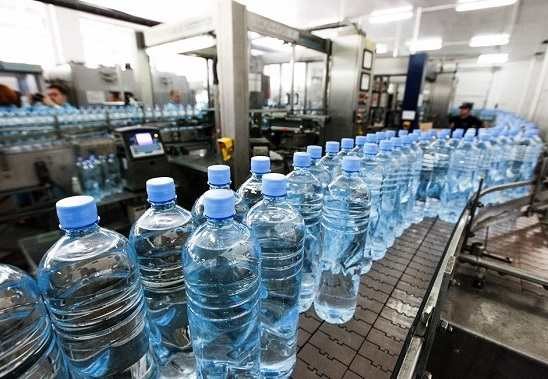
What are bad reverse osmosis filters?
There are disadvantages of reverse osmosis: reverse osmosis systems usually require a pressure of at least 3 atmospheres in the water supply, because water must pass through the membrane under pressure. Cleaning takes place ten times slower than sorption flow filters. In order not to force the user to wait until a glass of water is collected by drop, the reverse osmosis filters are completed with accumulative tanks. It is because of the bulky tanks of the reverse osmosis system occupy a lot of space under the sink - 2-3 times more than sorption filters.
Well, the main drawback for the average consumer: reverse osmosis filters are around 7-8 thousand rubles. Sorption filters for installation under the sink, for comparison, will cost 4-5 thousand rubles, pitchers and even cheaper - 400-800 rubles. But reverse osmosis systems are worth their money, because, I repeat, only they give complete water purification from any pollutants.
How does the reverse osmosis membrane
Despite its effectiveness in water purification, reverse osmosis membranes are quite sensitive to oxidizing agents (chlorine) and sediments, such as colloidal iron, which can “stain” the membrane surface. Therefore, in the reverse osmosis filters there are preliminary mechanical and sorption purification modules that filter chlorine, sand, dirt and mucus. After pretreatment, water enters the module with a membrane.
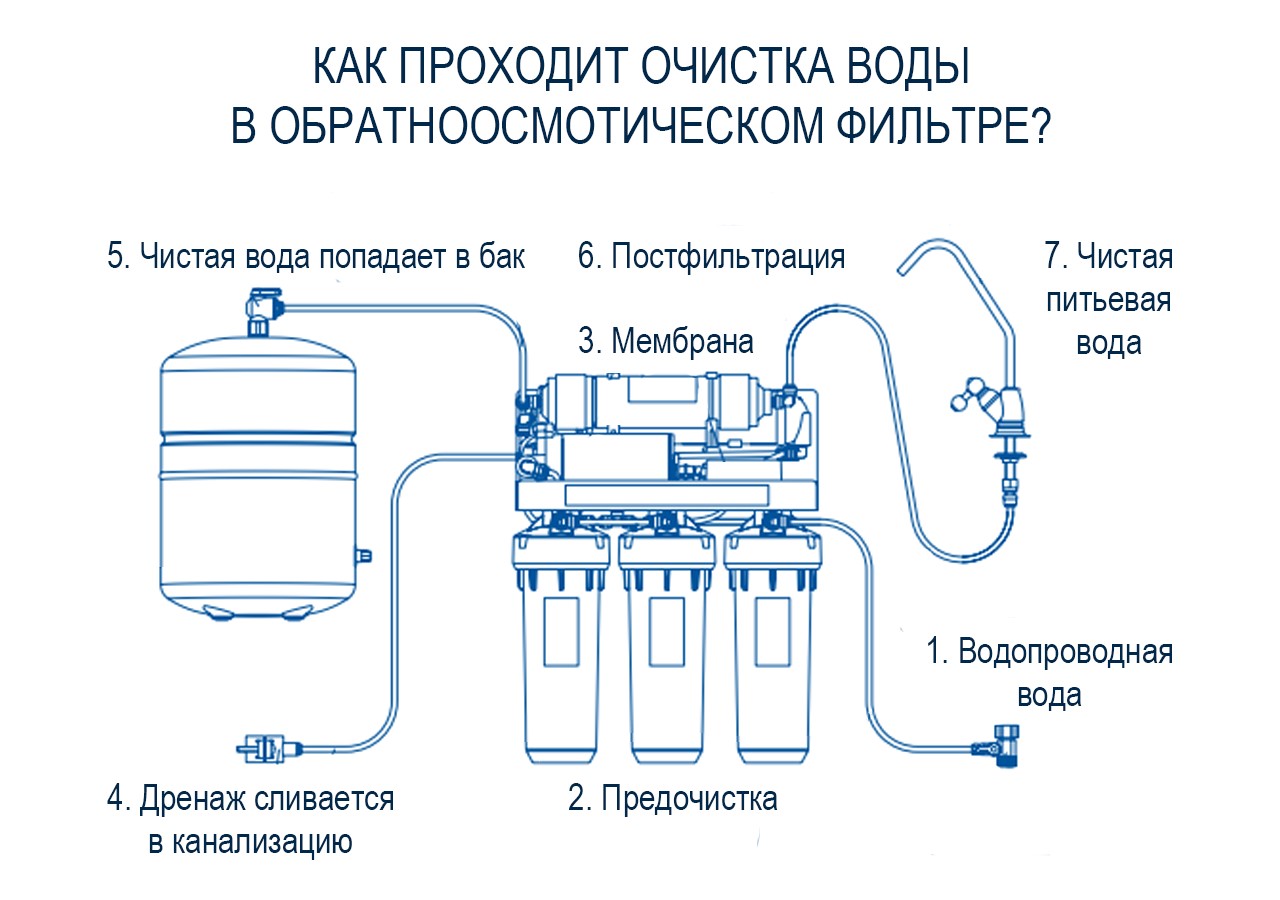
To explain the principle of the reverse osmosis membrane, you can give a simple example: juicer. Preferred water - fruit, filter - juice extractor, absolutely pure water - juice. Only in contrast to the juicer, the membrane can “squeeze” not only the “pulp”, which is an analog of undissolved impurities, but also substances that are dissolved in water.
Water with impurities under pressure is forced through the rolled-up membrane. All impurities - absolutely everything! - remain on the membrane itself, extremely clean water passes through. Another stream of untreated water passes along the membrane, washes away all impurities from it and sends them to the sewer. To get 1 liter of clean water, some filters consume as much as 10 liters of drainage water to flush the membrane.
The membrane itself in the promoted form does not represent anything of interest - a thin polymer material that feels like a masking tape to the touch. In the photo below - a piece of the membrane from the disassembled module from the filter in the hands of the spouse, who watched with interest our experiment.
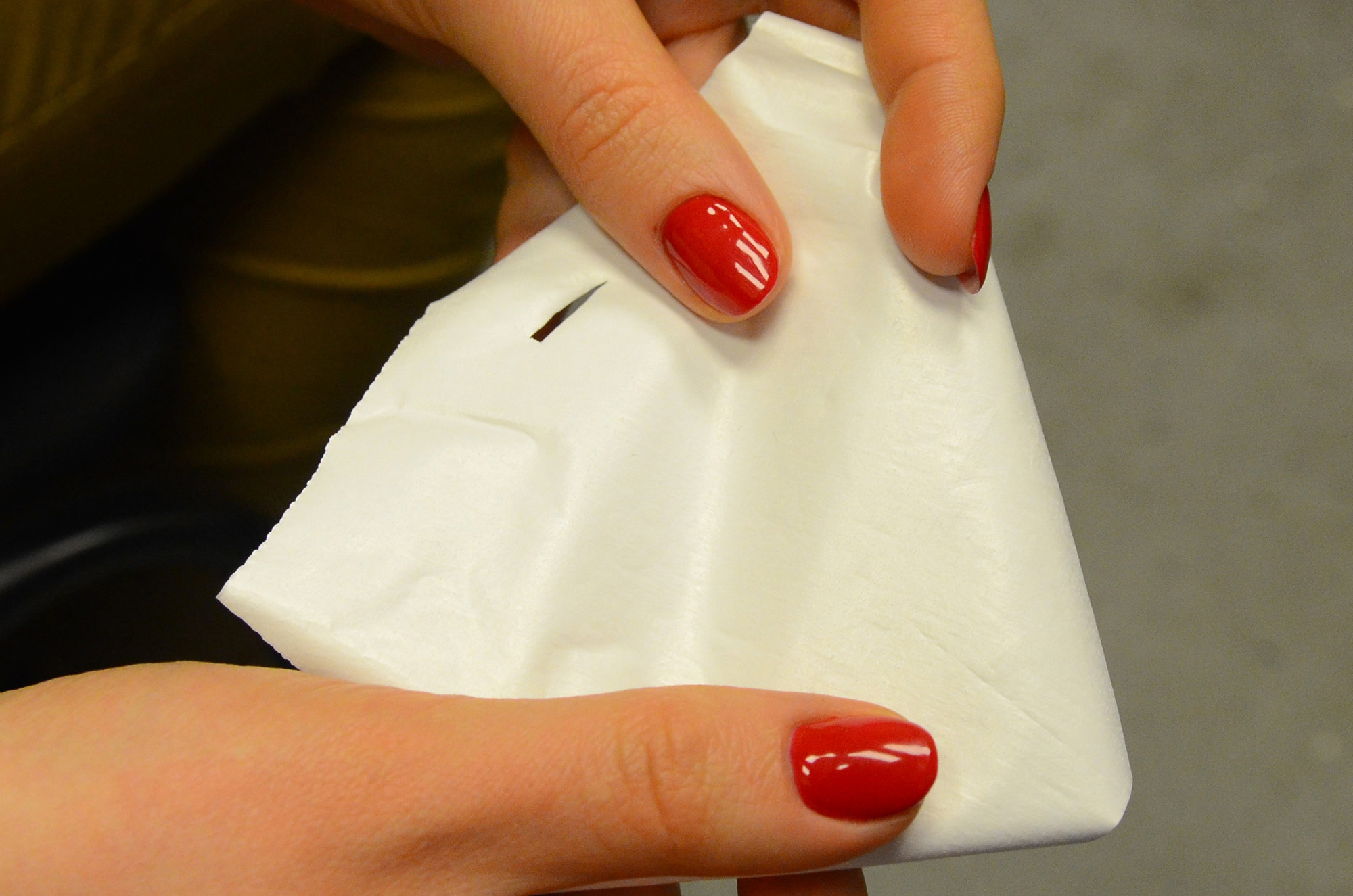
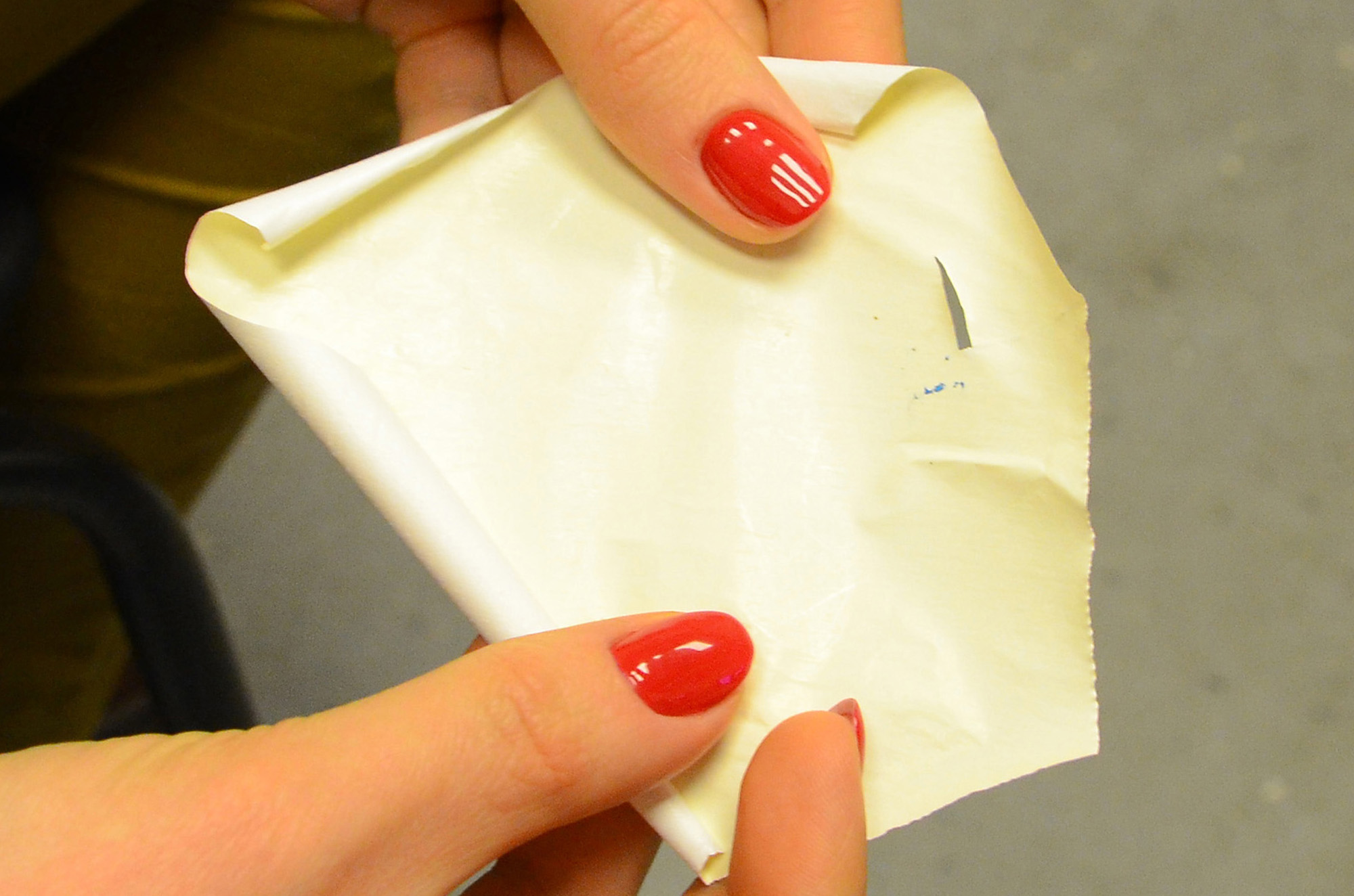
As mentioned above, so that people do not have to wait until the membrane filters the water, there are special tanks in the reverse osmosis filters that accumulate purified water. Tanks are from 3 to 18 liters in volume. The most common tanks have a volume of 18 and 12 liters. And clean water in them takes 12 and 9 liters, respectively - at least one third of the tank is air, under pressure of which water passes post-filtration and is fed to a separate tap. The system is called - water-air tank.
Not all membranes are equally useful?
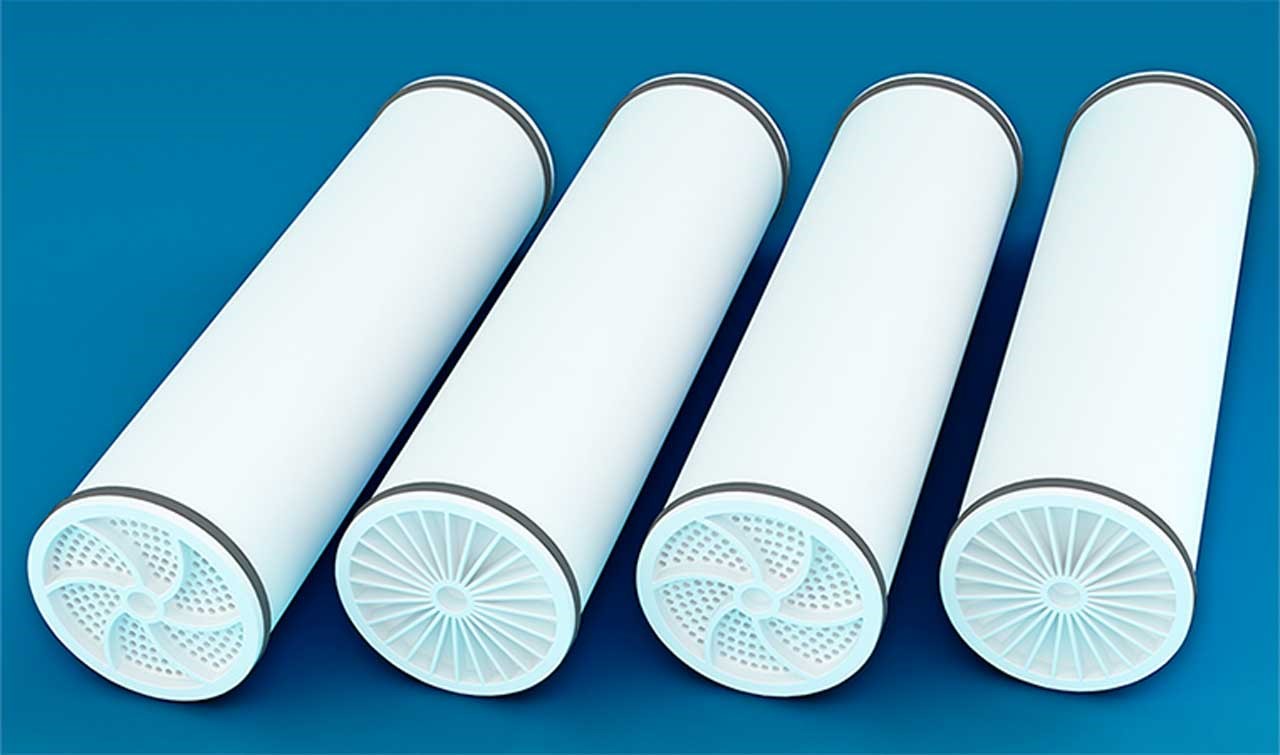
It turns out that none of the manufacturers of household filters independently produce reverse osmosis membranes - they are ordered from foreign suppliers. There are more expensive membranes, there are cheaper ones, but there is almost no global difference in terms of the effectiveness of water purification between different models of reverse osmosis filters. That is, colorful experiments with different solutions that we conducted during the
previous test , in the case of comparing reverse osmosis filters, will not give noticeable results.
But do reverse osmosis filters really differ only in names and price tags? Practice has shown no. After reviewing the reviews on Yandex.Market, I discovered several important criteria for comparing reverse osmosis systems:
- Dimensions. Many people have small kitchens, small sinks, and there is simply not enough space for a filter with a tank under the sink. Or enough, but I want to place there something else besides the filter.
- Cleaning speed Suppose you need more water than there is in the storage tank - it will take a long time to wait until it refills.
- Water flow. Of course, we do not live in Europe, and the water from the tap costs a penny. But if it is possible to buy a filter with a drainage ratio to purified water of 5 to 1 instead of 10 to 1, why not save? Moreover, water in almost all new homes is now counted by counters, and, as we know, the penny saves the ruble. Let me remind you that drainage water first consumes the resource of pretreatment modules. This directly affects item number 4.
- Cartridge service life. Of course, I want the cartridges to serve longer, because they are expensive - from 800 to 1 800 rubles, depending on the manufacturer and the type of cartridges.
- Ease of maintenance. Call the wizard 1 time to install the filter - wherever it went. But calling the wizard to replace the modules or bothering and working with the key yourself is not very convenient. It is more convenient when everything can be done with bare hands: simply and quickly.
- According to these criteria, we decided to compare reverse osmosis filters.
Practice: filter comparison
As I said earlier, in comparison of the effectiveness and efficiency of reverse osmosis systems,
the Aquaphor Morion (8,490 rubles) and
the Barrier Profi Osmo 100 filter (8,190 rubles) participated.
While I was preparing the material, and Aquaphor and Barrier rose slightly. Thanks to the reader who pointed out this defect. Above replaced the price tags on the current.
Dimensions"Aquaphor Morion" has dimensions of 37.1 x 42 x 19 cm. At first, I thought at all that they forgot to put the clean water tank in the box, but it turns out that the five-liter tank is already built into the case. That is, such dimensions - already taking into account the tank. At the same time, the “Barrier” filter has dimensions of 38.5 x 44.5 x 13 cm, and with it comes a 12-liter tank with a diameter of 23 cm and a height of 39 cm. You can estimate the difference in dimensions in the photo below:

From left to right: "Aquaphor Morion" in profile, "Aquaphor Morion" full face (this is not one filter in two parts, but two separate filters from different angles), and "Barrier Prof Osmo 100".
Cleaning speedThe membranes in the compared filters differ in the stated performance. The Aquaphor filter uses a 50-gallon membrane (50 gallons = 189 liters per day). The “Barrier” filter contains a 100-gallon membrane (378 liters of water per day). Logically, the performance of the filter "Barrier" should be twice as high.
To estimate the actual filtration rate (and not the rate of water supply from the storage tanks), we began the test with an empty storage tank for both filters. The cleaning speed of the filters “Aquaphor” and “Barrier” differs by 1.5 minutes / liter: “Aquaphor” cleans a liter of water in 7.5 minutes (8 liters per hour), “Barrier” - in 6 minutes (10 liters per hour ). In principle, these figures are close to 7.8 liters per hour at the Aquaphor manufacturers and 12 liters per hour at the Barrier. But, as you can see, there is no double performance difference.
For the sake of justice, it is worth noting that for the Aquaphor Morion model, a 100-gallon membrane is also sold separately, which should ensure a productivity of 15.6 liters per hour. More productive than the Barrier, and almost 200 rubles cheaper.
 Water flow
Water flow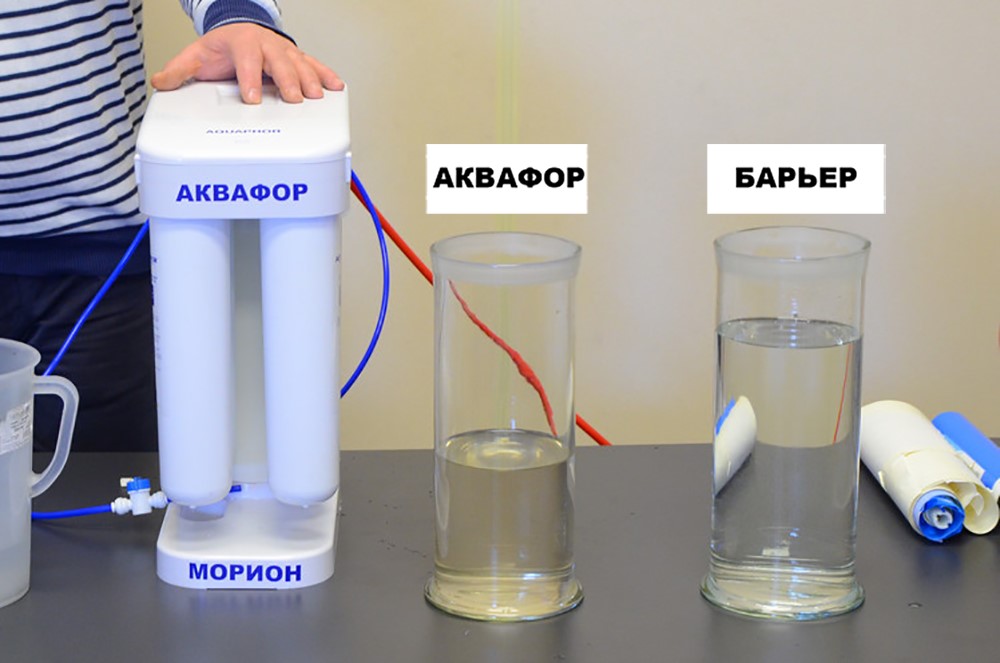
The difference in drainage volumes turned out to be significant - you can evaluate it from the photo above. "Aquaphor" to obtain 0.75 liters of clean water consumes 1.3 liters of drainage, "Barrier" - about 2.5 liters. With a different water pressure and with a different water quality, the values may be different, but the ratio of water consumption for drainage between Aquaphor and the Barrier should be maintained - 1 to 2 in favor of Aquaphor.
Where does such a difference in size, performance and water flow come from?
To achieve such a difference in size, speed and efficiency, "Aquaphor" could, thanks to its own development - a water-water storage tank. Here is a video that explains in detail the device of this system:
Briefly about the point: in a normal reverse osmosis filter, when the tank is completely filled with water, one third of the tank remains empty - it is filled with air. Therefore, these tanks are so big. As pure water accumulates, the pressure in a conventional storage tank increases, making the filtration rate lower, and the volume of water discharged into the drainage increases. In the case of the Aquaphor Morion water tank, the water from the control cavity is drained without creating resistance, and the tank filling rate remains constantly high. From here - high performance, economical consumption of water for drainage.
And, by the way, for residents of old houses one more advantage of the development of the Aquaphor is important: according to the instructions, the Morion filter
can operate at a pressure of 0.2 MPa (approximately 2 atmospheres), whereas most reverse osmosis systems require 3 atmospheres and more. At the Barrier participating in comparison, for example, in
the operation manual the working pressure from 3,5 to 7 atmospheres is specified.
Cartridge lifeLet's return to the comparison. How long will the cartridges last in the Aquafor and Barrier filters, how often should they be changed?
“Aquaphor” on the site
cites the following figures (calculated for a family of 3 people): the K5 prefiltration modules (315 rubles), K2 (540 rubles) need to be changed twice a year. K7M post filtering module (540 rubles) - once a year. The module with a membrane (K50S for 1 895 rubles) needs to be changed once a year and a half.
The total total expenses per year will be (540 p + 315 p) * 2 + 540 p + 1 895 p / 1.5 = 3 513 rubles.

On the Barrier website, a filter resource of 5 thousand liters is indicated, and it is additionally indicated that for a family of 3 people it will be necessary to change cartridges every 160 days (365/160 = 2.3 times a year).
A full set of 5 cartridges costs 3,190 rubles, respectively, the annual cost will be 3,190 * 2.3 = 7,334 rubles.
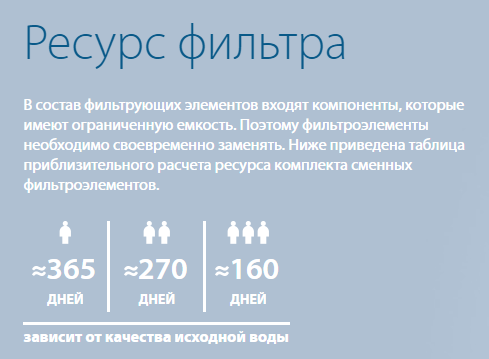
A more attentive user will examine the catalog on the Barrier site and find that a separate module with a membrane for 2,320 rubles
indicates the service life of 340 days - a little less than a year.
That is, if you do not get caught with the trick of imposing a complete set, and buying modules separately, the annual expenses of a family of three people will be (99 + 490 + 139 + 599) * 2.3 + 2 320 = 5 372 rubles.
Naturally, resource figures specified by manufacturers are conditional and depend on many factors, for example, on pressure and on water quality. But the proportion, all other things being equal, should be preserved: “Aquaphor” turns out to be at least one and a half times more economical, and the module with a membrane it serves 1.5 times longer than that of the Barrier.
Why does the “Aquaphor” membrane serve for one and a half years, while the Barrier has less than a year? We will risk to assume. As mentioned above, the reverse osmosis membrane is a sensitive thing. An important role in the duration of the membrane is played by the quality of the water that is fed to this membrane.
In both filters there are polypropylene modules for mechanical water purification from sand and rust - they remove the largest particles of pollutants from the water. They are followed by sorption modules - they are similar in structure and content to the modules of sorption filters, which were compared in the
previous test . At the Barrier inside the sorption modules the usual granular activated carbon. In the sorbent cartridge "Barrier" water under pressure can flush the channels through which it will pass quickly and not being cleaned properly. That is, over time, water with large particles of pollutants may start to enter the membrane of the Barrier, which negatively affects its service life and the quality of water purification.
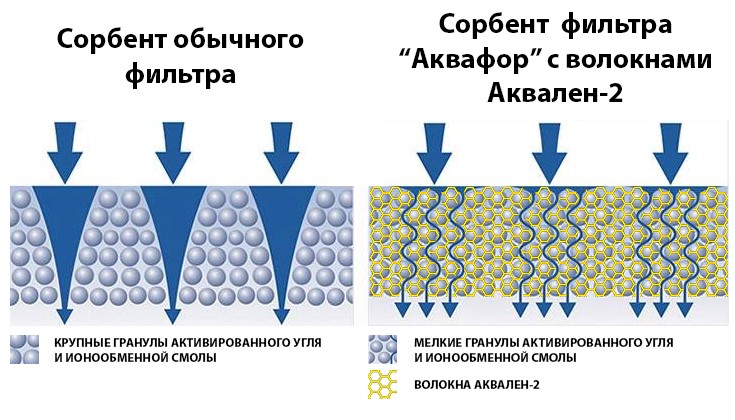
Remember this circuit from my
test comparison ? In the case of “Aquaphor”, the channel effect cannot be formed due to the use of the company's own development, a module made using a special technology: granulated coal was “sintered” with “Aqualen” fiber, having received a single unit. In such a material, in principle, no channels are formed. Accordingly, the membrane in the Aquaphor filter gets cleaner water and lasts longer.
Easy cartridge replacement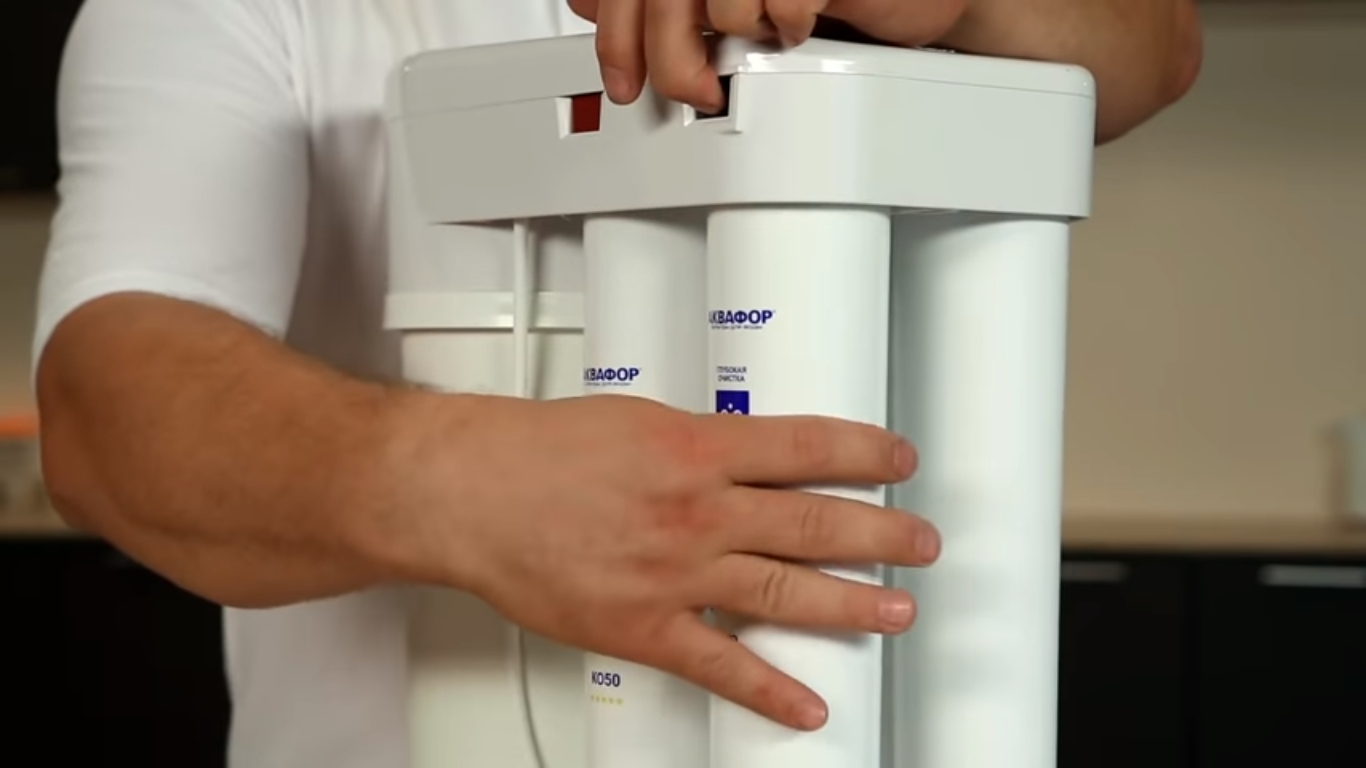
There is nothing to compare. Replacing modules in the Aquaphor filter is simple: the cartridges are unscrewed like light bulbs. Contact with the contents of the flasks will not have to wash nothing.
An example on the video:
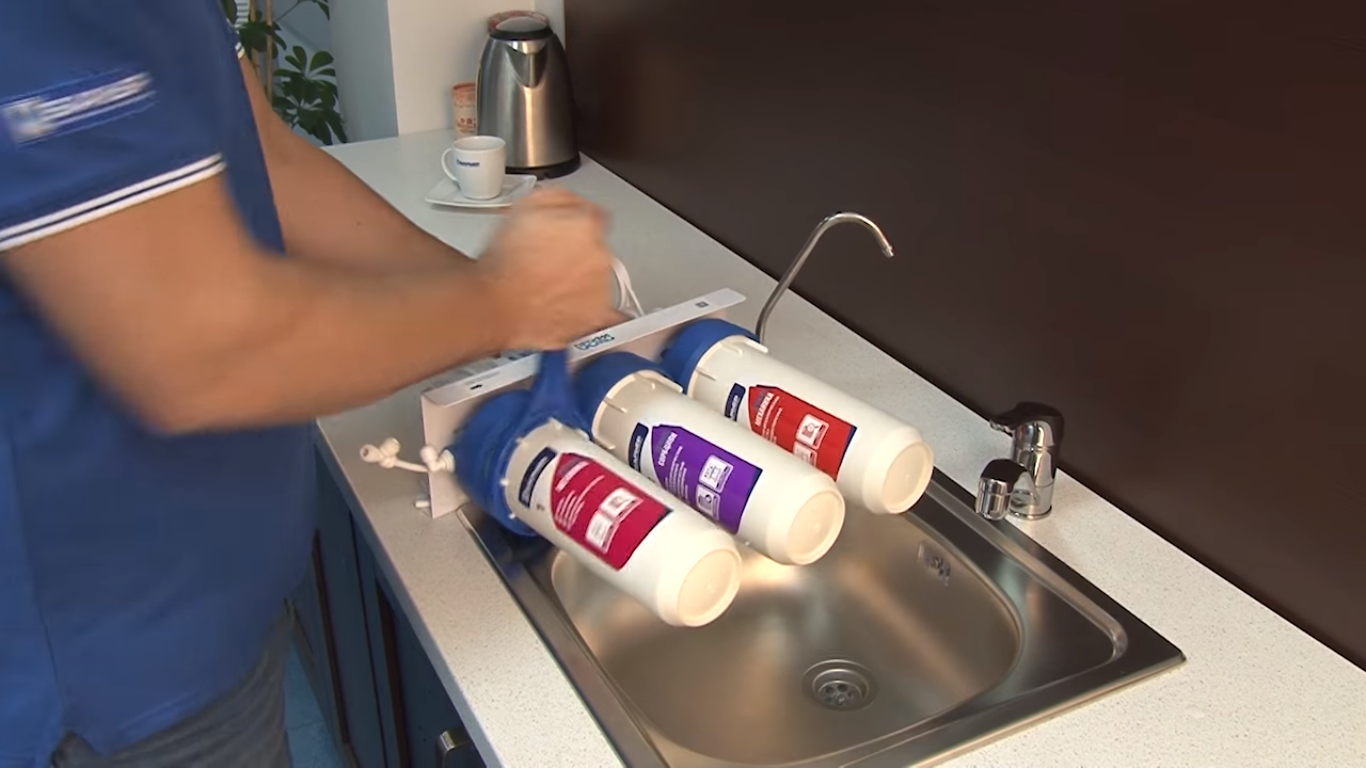
The Barrier will have to work with a key and rinse the flasks.
The installation process is shown on the video below:
I would like to note that when working with cartridges that have been used for a long time, you need to be careful. All cut-off bacteria and microbes can remain inside the plug-in module and continue to multiply there. They will not get into the water through the membrane, but if you get inside the cartridge, be extremely careful.
In general, “Aquaphor” is decidedly simpler in terms of maintenance: modules can be changed “on click”, no tools will be required. And contact with the contents of the cartridges is also not necessary, which is even more important.
findings
You can try to scold me for bias, but all the facts are before my eyes. Yes, both participants in the comparison give the output equally clean water - in this regard, the rivals are not inferior to each other. But according to other parameters, the Aquaphor filter is leading. “Barrier” won in only one - in comparison of performance: through the use of a 100-gallon membrane. Akvafor Morion has only a 50-gallon membrane, a 100-gallon membrane can be bought separately for about 2,000 rubles.

Thanks to the water tank built into the case, the Aquaphor Morion filter is almost twice as compact as the Barrier Prof Osmo 100 filter. But through the use of a water tank, the performance varies - in our test, the Morion with a 50-gallon membrane cleaned water 20% slower than the Barrier with a capacity of 100 gallons per day. With a 100-gallon membrane at the Aquaphor Morion filter, the manufacturer claims performance is 40-50% higher than that of the Barrier Profi Osmo 100. But we could not verify this, since the sample with a 50-gallon membrane was on the test.
The difference in water consumption for drainage is also in favor of the Aquaphor: 1.7 liters of drainage per liter of clean water, and at the same level as the “Barrier” filter - 3.3 liters.
The service life of membranes is significantly different: a year and a half in Aquafor against a year in Barrier. This may be due to the use of another Aquaphor development, a block with Aqualene-2 fibers, in water pre-treatment modules. The inlet membrane receives water with a smaller amount of oxidizing agents and macro-impurities (large particles of pollutants) than in the case of the Barrier, therefore, it serves one and a half times longer.
These are the conclusions. Both filters in the assembled working condition are still in the laboratory. We can conduct some additional tests if you are interested. Again, I am ready to answer questions in the comments - ask.
PS And finally, some information in the wake of my
first test-comparison . As well as responses to comments on the first article.
1) After a day or two after the release of the report on the first test, the official representatives of the brand “Geyser” came to the comment. In the course of a long, rather entertaining correspondence, I did not receive reliable data that would refute my conclusions, and in general some specificity on the topic. The representative tried hard to talk me out, without answering direct and understandable questions, the answer to which would have shed light on the results of my first test. As a result, "Geyser" just pressed, promising legal problems to me and to the resource Geektimes. As a result, I was forced to remove a fragment of the article with the mention of their filter. Instead, I put this disclaimer:

2) For those who doubted the plausibility of the results of the “blue test” and asked for a video. Under the link below you will see a video clip that shows the “fascinating” process of water purification from the dye with three jug filters — Barrier, Aquaphor, and Brita.
But - rust removal:
3) One of the commentators was indignant that we compare the flow sorption filter with the "osmosis". I consider it important to explain the choice of the comparison participants, first, and second, to tell about the differences in the reverse osmosis and hollow fiber membranes.
Why were different types of filters compared? For a real user, not the cleaning technology is important, but the result. If there are two filters from the same price category, and both promise water purification from bacteria, I consider it normal to compare their effectiveness. In addition, the promise of "100% removal of viruses from the water" on the box is NOT a membrane filter, I confess, intrigued.
Further. Hollow fiber and reverse osmosis membranes are completely different things. Even visually:
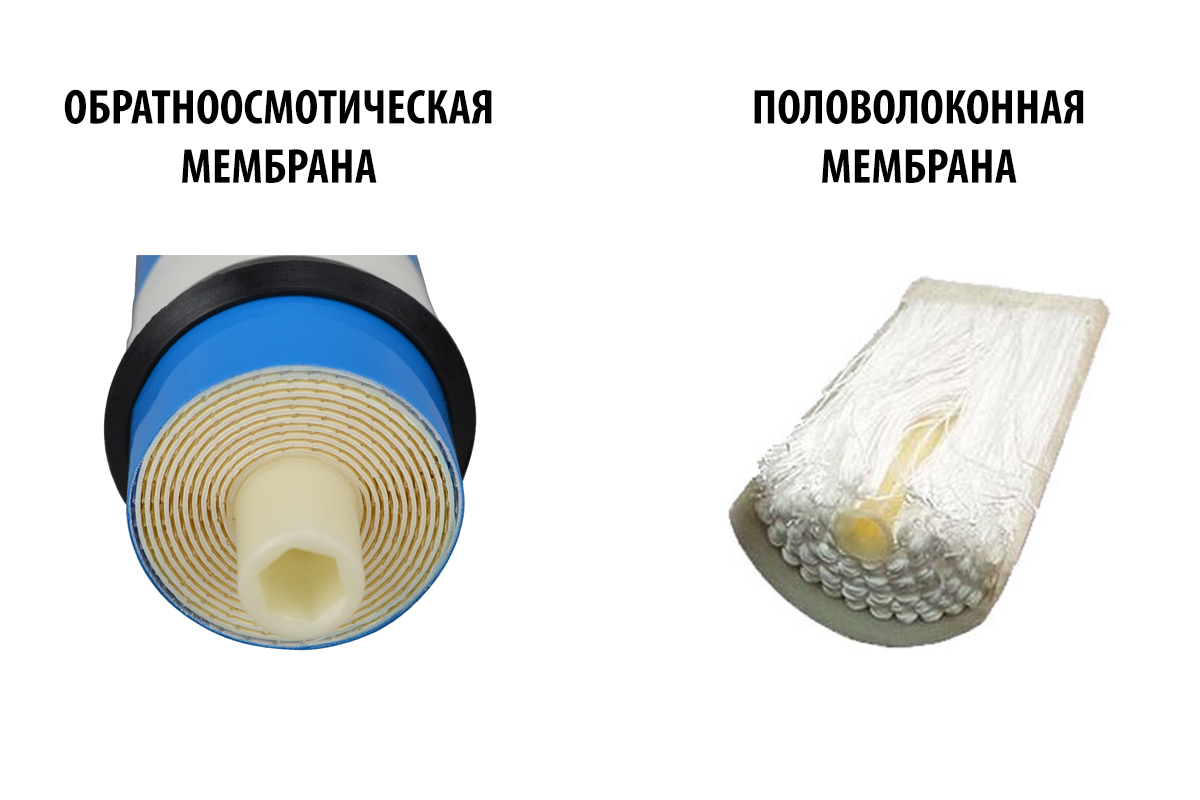
The hollow fiber membrane used in the filter cartridge Aquaphor Crystal Eco - tube with a diameter of about 1 mm with porous walls. The pore size is 0.1 microns, which is 600-800 times smaller than the thickness of a human hair. Water is filtered through the walls of the tubes.
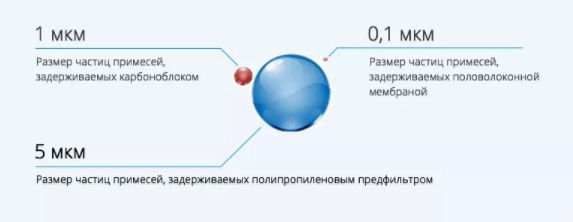
The hollow fiber membranes are removed from the water mechanical impurities with a particle size of 0.1 microns, retain microorganisms and bacteria, remove lamblia cysts. This was demonstrated by the last test: the Akvafor K7B cartridge removed particles of hematite from water, similar in size to bacteria, and gave clear clear water.

And yet, the hollow fiber membrane does not guarantee water purification from viruses, like reverse osmosis. Therefore, I didn’t tell the brand of what kind of filter (or they’ll come again for me) I compared with the filter based on the hollow fiber membrane, and not with the reverse osmosis membrane filter, which would be really unfair.